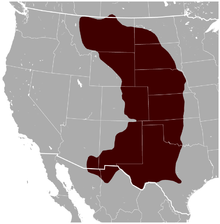
Back كلب المروج أسود الذيل Arabic كلب المروج اسود الذيل ARZ Cynomys ludovicianus AST Vugzol (Cynomys ludovicianus) AVK Черноопашато прерийно кученце Bulgarian কালো লেজ প্রেইরি কুকুর Bengali/Bangla Gosset de les praderies cuanegre Catalan Cynomys ludovicianus CEB کتکەسمۆرەی کلک ڕەش CKB Psoun prériový Czech
| Black-tailed prairie dog | |
|---|---|

| |
| At Grasslands National Park | |
| Scientific classification | |
| Domain: | Eukaryota |
| Kingdom: | Animalia |
| Phylum: | Chordata |
| Class: | Mammalia |
| Order: | Rodentia |
| Family: | Sciuridae |
| Genus: | Cynomys |
| Species: | C. ludovicianus
|
| Binomial name | |
| Cynomys ludovicianus (Ord, 1815)
| |

| |
| Black-tailed prairie dog range[1] | |
The black-tailed prairie dog (Cynomys ludovicianus) is a rodent of the family Sciuridae (the squirrels) found in the Great Plains of North America from about the United States–Canada border to the United States–Mexico border.[3] Unlike some other prairie dogs, these animals do not truly hibernate. The black-tailed prairie dog can be seen above ground in midwinter. A black-tailed prairie dog town in Texas was reported to cover 25,000 sq mi (64,000 km2) and included 400,000,000 individuals.[4] Prior to habitat destruction, the species may have been the most abundant prairie dog in central North America. It was one of two prairie dogs described by the Lewis and Clark Expedition in the journals and diaries of their expedition.
- ^ a b Cassola, F. (2017) [errata version of 2016 assessment]. "Cynomys ludovicianus". IUCN Red List of Threatened Species. 2016: e.T6091A115080297. doi:10.2305/IUCN.UK.2016-3.RLTS.T6091A22261137.en. Retrieved 19 February 2022.
- ^ "Cynomys ludovicianus". NatureServe Explorer An online encyclopedia of life. 7.1. NatureServe. Retrieved 22 October 2023.
- ^ Musser, Guy (October 26, 2023). "Prairie dog". Encyclopedia Britannica. Retrieved November 3, 2023.
- ^ "Prairie Dogs | National Geographic". 2010-11-11. Archived from the original on February 24, 2017. Retrieved 2018-06-13.

